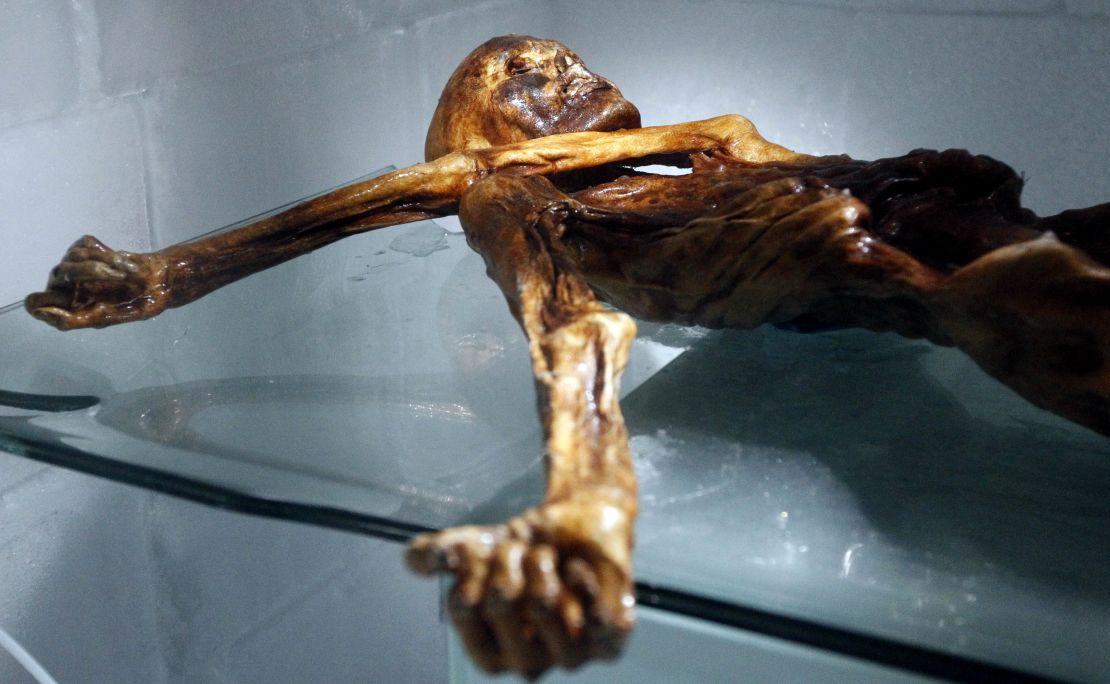Story highlights
Italian researchers are trying to recreate the voice of Otzi, a 5,300-year-old mummy
They hope to have a digital simulation in one year
He hasn’t talked for 53 centuries, but Otzi the Iceman may be about to break his silence.
Italian researchers in the northern city of Bolzano are working to recreate the 5,300-year-old man’s voice.
“In about a year we should be able to give Otzi a voice – or at least recreate the best possible approximation of his voice,” project coordinator Francesco Avanzini, ENT specialist at the city’s San Maurizio Hospital, told CNN.
In what he claims is the first such experiment ever carried out on a mummy, Avanzini and his colleagues have used CT scans to create a model of Otzi’s vocal tract, including the vocal cords and his mouth. Researchers at the National Research Council in Padua will then use this model and special software to recreate the Iceman’s voice.
“Of course we don’t know what language he spoke 5,000 years ago,” Avanzini said.
“But we should be able to recreate the timbre of his vowel sounds and, I hope, even create simulation of consonants.”
Working with a 5,300-year-old mummy preserved in special conditions, researchers faced several problems, Avanzini explained. They had to make some assumptions about the body’s soft tissues that affect the human voice, for example.
“Another big problem is his position, with an arm covering his throat and hyoid bone, which is also dislocated,” he said.
“For our project, the arm is in the worst position you can imagine.”

Despite these problems, researchers say they are optimistic. They expect the first results to come in a few months, and within one year we may be able to listen to Otzi.
“We would like to create a digital file, so that visitors at the museums can hear the Iceman’s voice,” Avanzini said.
READ: Bringing life to Peru’s ancient mummies
Who is Otzi the Iceman?
Discovered in 1991 poking out of a glacier in the Italian Alps, Otzi is one of the oldest mummified person ever found. As a comparison, Egyptian mummies are several hundred years younger. He rests in a special cell – at exactly -6 C (21 F) and 98% humidity – at the South Tyrol Museum of Archaeology in Bolzano, where he is the undisputed star.
For the past 25 years, his mummified body has been a window into the early human history. His remains are a treasure trove of information on what life in the Alpine region was like more than 5,000 years ago, while also revealing details of Otzi’s life and violent death.
According to the EURAC’s Institute for Mummies and the Iceman, and the South Tyrol Museum, Otzi was about 1.6 meters (5.2 feet) tall and weighed about 50 kilos, or 110 pounds. He probably had dark, shoulder-length hair and beard. Sixty-one tattoos cover his body. Based on their position, researchers think they were part of a pain relief treatment of joints.

DNA and other analyses revealed he had brown eyes and was in poor health – unsurprising given his age. At 45, he was rather old back then. Otzi was genetically predisposed to cardiovascular diseases and suffered from hardened arteries, lactose intolerance and dental problems. He might have also suffered from ulcers, and scientists found evidence of whipworm, an intestinal parasite.
READ: 3,000-year-old fingerprints found on ancient Egyptian coffin lid
More surprisingly, his descendants can still be found in in some isolated European regions, such as Italy’s Sardinia and France’s Corsica.
Examining his wounds, researchers found the oldest red blood cells ever discovered. We even know what his attire looked like and what weapons and equipment he used.
One of the most intriguing aspects, though, is the manner of his death. A flint arrowhead was found in his left shoulder, which had probably cut a key blood vessel: Otzi was murdered.
Pollen in his stomach tell us that the killing probably took place during the spring, while other stomach samples show that, at least, he had a good lunch before dying: corn, meat and fruit.
What we don’t know is what he was doing more than 3,000 meters up in the Italian Alps and why he was killed. And even when Otzi will speak, it is unlikely to reveal his last secrets.
READ: 350-year-old Bishop corpse found with mysterious fetus




